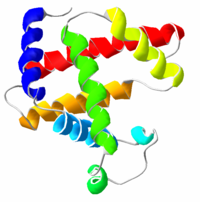Myoglobin
|
|
Myoglobin is a single-chain protein of 153 amino acids, containing a heme (iron-containing porphyrin) group in the center. With a molecular weight of 16,700 Daltons, it is the primary oxygen-carrying pigment of muscle tissues. Unlike the blood-borne hemoglobin, to which it is structurally related, this protein does not exhibit cooperative binding of oxygen. Instead, the binding of oxygen by myoglobin is unaffected by the oxygen tension in the surrounding tissue. In 1957, John Kendrew and associates successfully determined the structure of myoglobin by high-resolution X-ray crystallography.
For this discovery, John Kendrew shared the 1962 Nobel Prize in chemistry with Max Perutz.
Role in disease
Myoglobin is the putative protein that causes acute renal failure in rapid breakdown of muscle (e.g. rhabdomyolysis, severe crush trauma, malignant hyperthermia, status epilepticus and neuroleptic malignant syndrome), due to its toxicity to renal tubular epithelium.
Myoglobin is a sensitive marker for muscle injury, making it a potential marker for myocardial infarction in patients with chest pain. Its specificity and the cost of the analysis has prevented its widespread use.
See also
External links
- oxy-myoglobin at 0.1 nm resolution: PDB 1A6M (http://www.rcsb.org/pdb/cgi/explore.cgi?pid=105291034356398&page=0&pdbId=1A6M)
- Sperm whale myoglobin at 0.17 nm resolution: PDB 1VXH (http://www.rcsb.org/pdb/cgi/explore.cgi?pid=255731034609024&page=80&pdbId=1VXH)da:Myoglobin
de:Myoglobin eo:Mioglobino es:Mioglobina fr:Myoglobine ja:ミオグロビン

